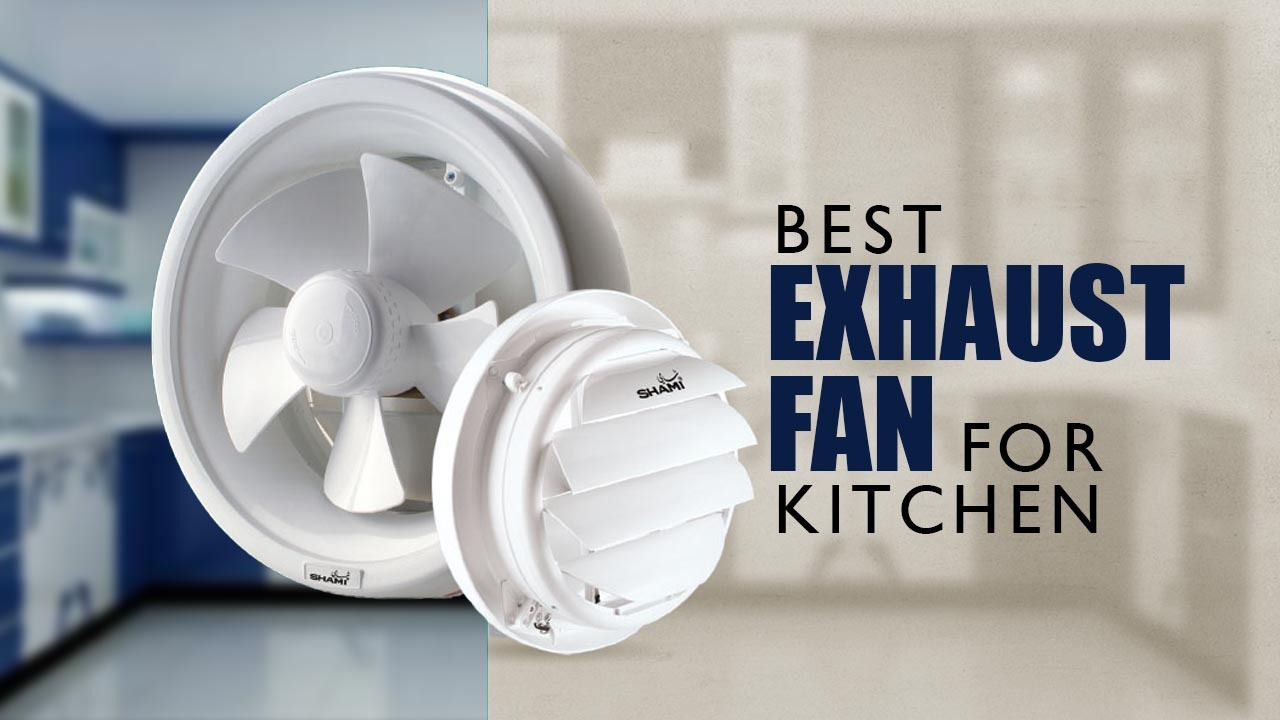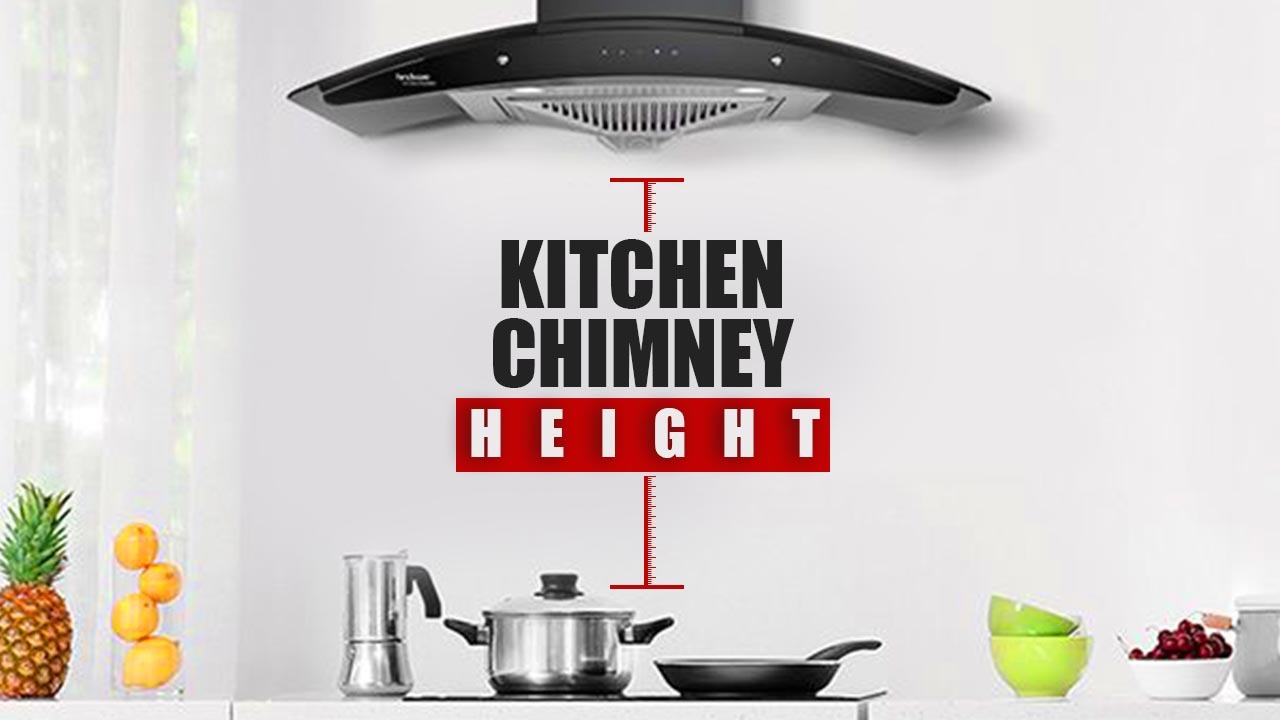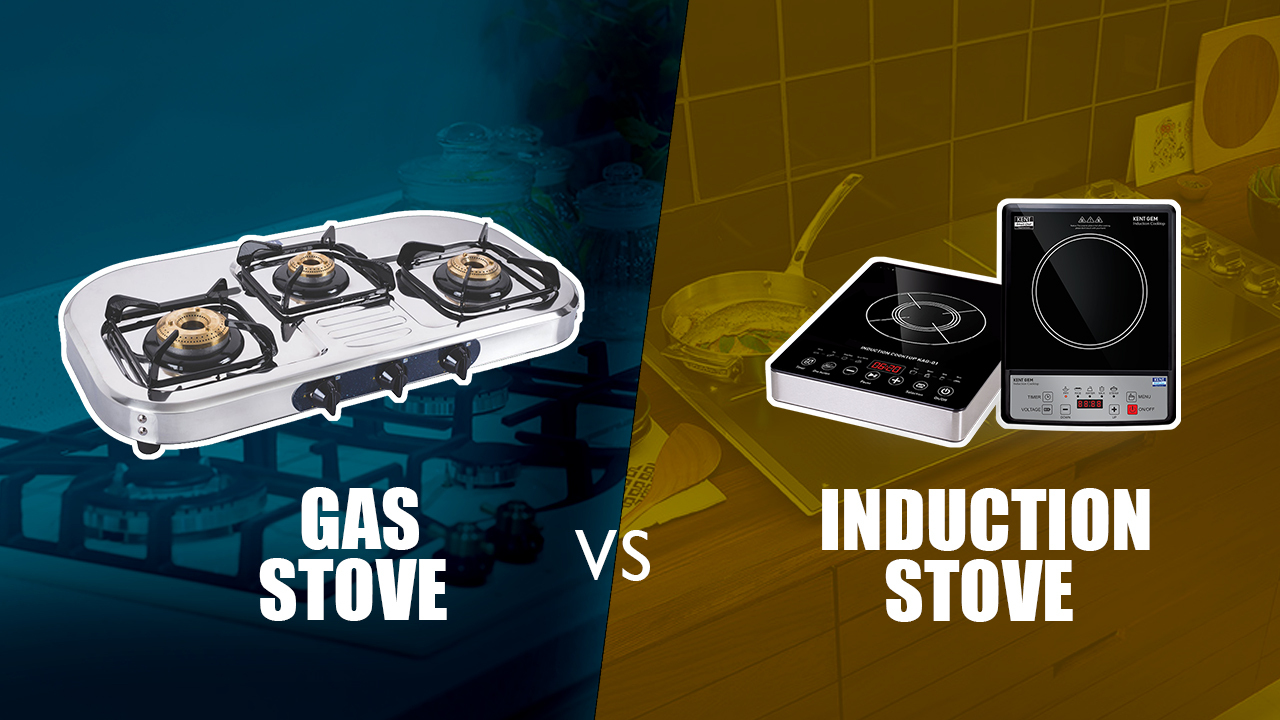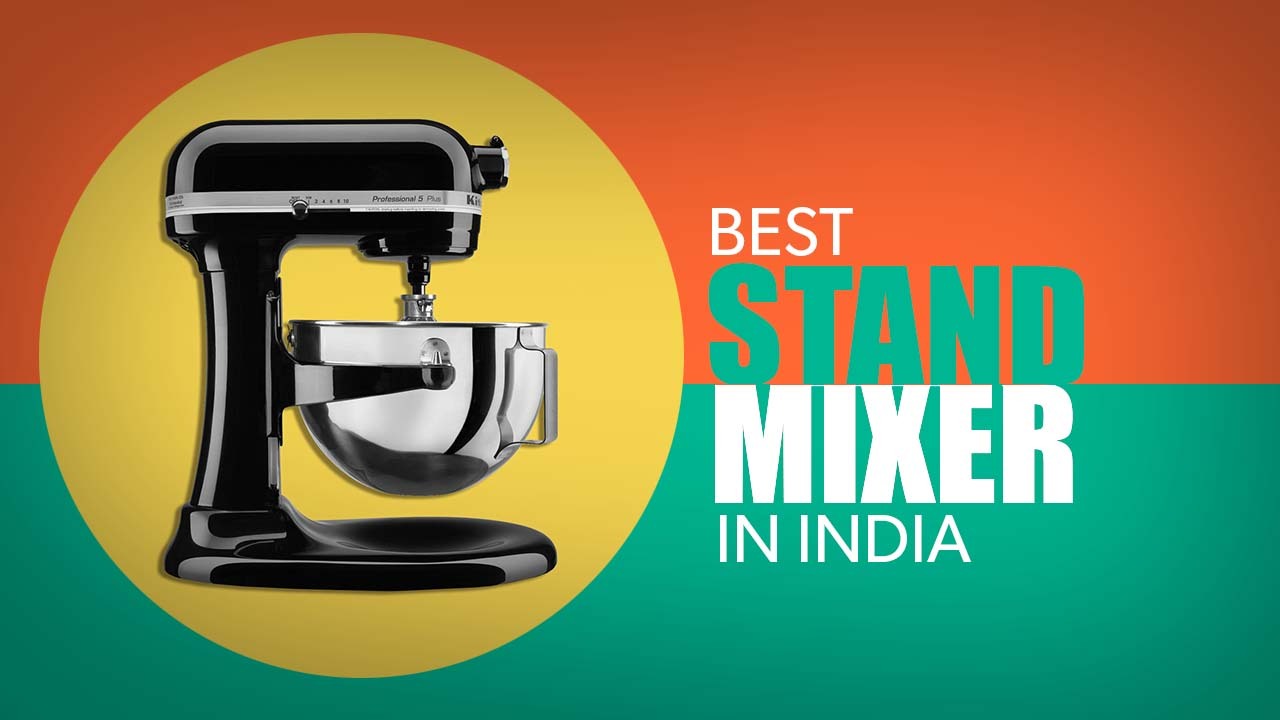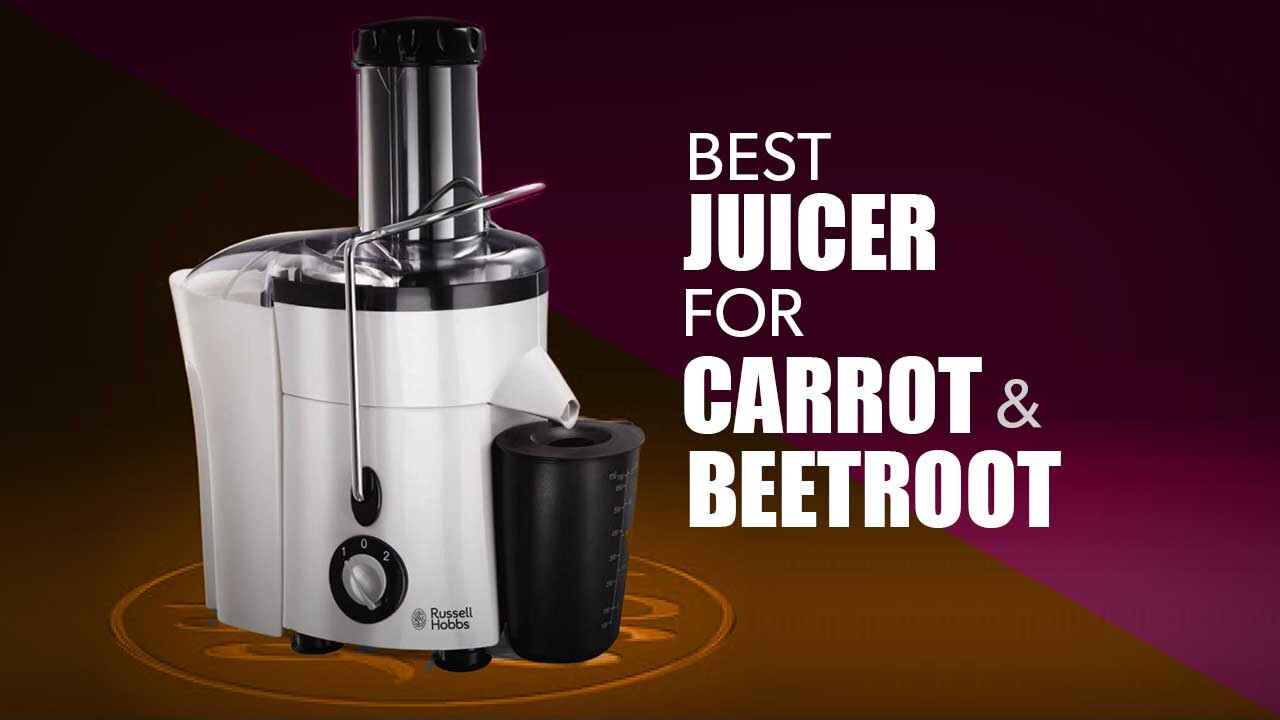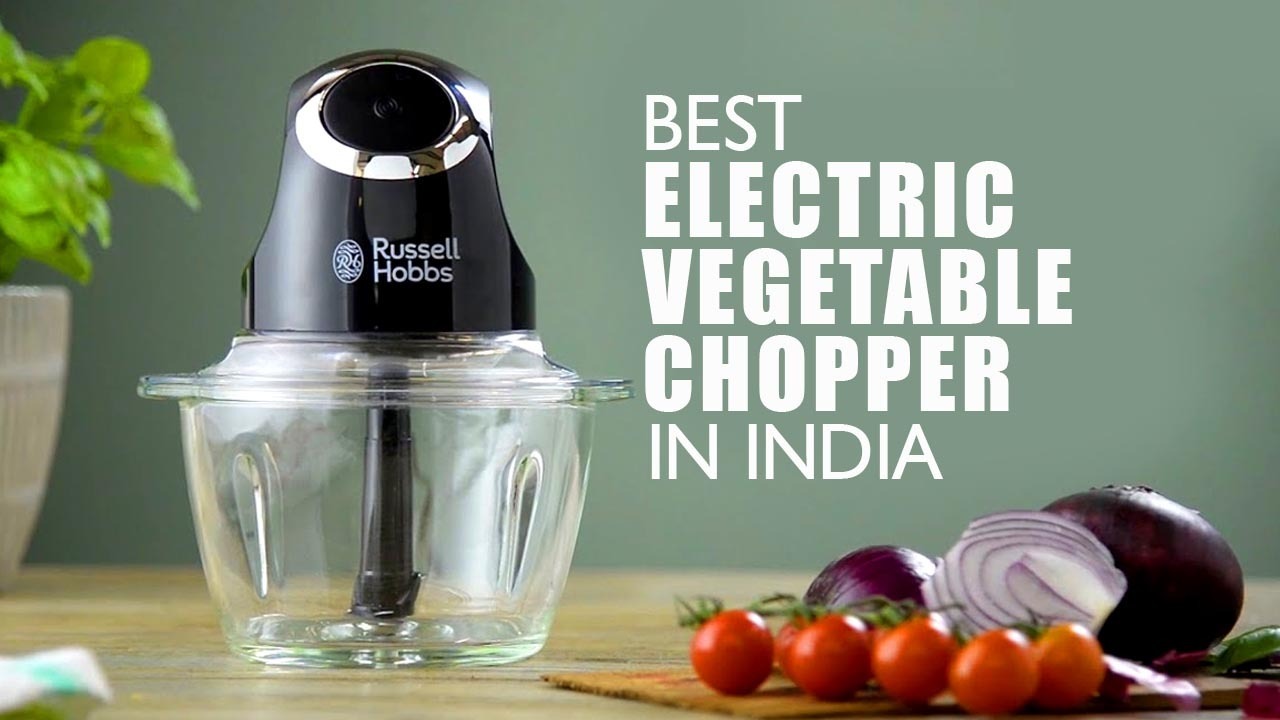The best electric beater in India (also called electric whisk) is a small appliance used to prepare different types of recipes, mixing, or kneading the ingredients quickly and quickly, thanks to the electric whips or hooks. The electric device is used both in savory preparations, such as bread, focaccia, pizza, and sauces, such as mayonnaise and cocktail sauce, as well as in sweet ones.
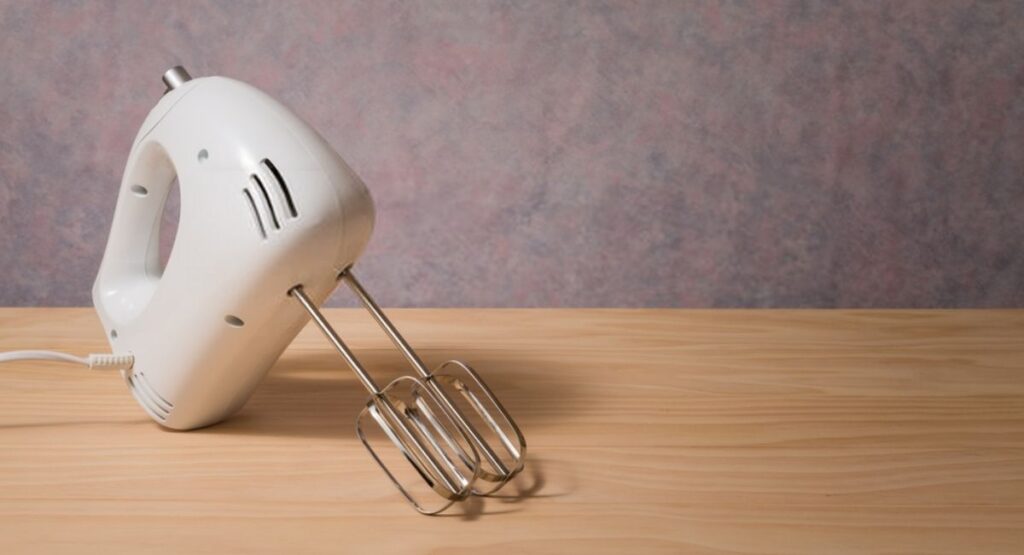
Using an electric beater also and allows you to obtain better results than those you would get by beating the mixture by hand. This small but useful appliance also allows you to save time and effort by working the compounds in just a few minutes.
If you are interested in buying an electric beater, however, you must keep in mind that the market offers really many, and all very different. It is therefore essential to identify the features, dimensions, and price that best suit you, so that you can buy this appliance and then feel fully satisfied.
List of best electric beater in India with price
This comparison of the best electric beater in India brings together the products that stand out on the market for their impeccable quality. The selection was made objectively on the basis of a number of important criteria such as: functionality, performance, practicality, design quality and customer reviews.
| S. No. | Best Electric Beater In India | Price |
| 1. | Philips 300-Watt Electric Beater (HR3705/10) | Rs. 1,949 |
| 2. | Inalsa 250-Watt Electric Beater (Easy Mix) | Rs. 999 |
| 3. | Prestige 300-Watt Electric Beater (PHM 2.0) | Rs. 1,449 |
| 4. | Bajaj 250-Watt Electric Beater (HM-01) | Rs. 1,699 |
| 5. | iBELL 120-Watts Electric Beater (IBLWHITES03NEW) | Rs. 735 |
| 6. | Usha 300-Watt Electric Beater (3732) | Rs. 1,801 |
| 7. | Orpat 150-Watt Electric Beater (OHM-207) | Rs. 930 |
| 8. | Morphy Richards 300-Watt Electric Beater (HM02) | Rs. 2,245 |
| 9. | Wonderchef Electric Beater (Oynx) | Rs. 1,799 |
| 10. | Black and Decker 250-Watt Electric Beater (MX3200B) | Rs. 4,692 |
📌 You might also like these articles:
– Best food processors
– Top 10 best hand blenders in India
– Best stand mixer for baking in India
Best electric beater in India reviewed
1. Philips 300-Watt Electric Beater (HR3705/10)
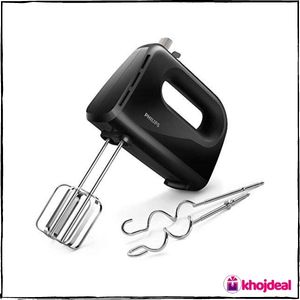
Why we like this electric beater?
Kneading, mixing, and whisking are now going to be easy and effortless with this Philips electric beater in your kitchen. This cone-shaped beater works up to 20% faster than other beaters covering a larger surface area in less time and incorporating air into the batter for a smooth, fluffy texture. The beater comes with five dedicated speed settings that you can choose from according to the kind of dish you are making.
The Philips Daily Collection HR3705/10 electric beater comes in a lightweight, ergonomic design that makes all your mixing easy and comfortable. The cord wraps around and fixes into place with a clip for tidy storage. Smooth surfaces and dishwasher-safe accessories make for fast, easy cleaning. Beaters and dough hooks attach easily with a click. A large and clear eject button makes them easy to remove as well with one touch.
Key features & specifications
- Power: 300 watts
- Operating voltage: 220-240 volts
- Includes 2 pairs of stainless-steel strip beaters & dough hooks
- Cord length: 1.2m
- 5 speeds plus turbo for a variety of recipes
- Warranty: 2-year warranty from the date of purchase
- Cord clip for tidy storage
- Eject button
- Smooth surfaces for easy cleaning
- Dishwasher safe accessories
- 5 speeds + Turbo
- Lightweight and designed for comfort
Pros & Cons
Pros (What we liked)
- Cord wraps around and fixes into place with a clip for tidy storage
- Large eject button to release beaters with one touch
- Smooth surfaces & dishwasher-safe accessories make for fast, easy cleaning
- 5 different speed settings let user chose just the right setting for every task
- Lightweight, ergonomic design makes mixing comfortable and easy
Cons (What we didn’t like)
- Sudden start of the blades sometimes causes the ingredients to fly out
2. Inalsa 250-Watt Electric Beater (Easy Mix)
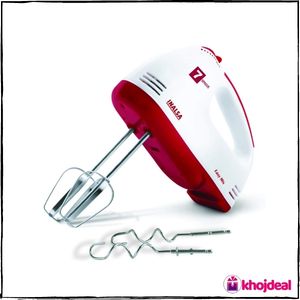
Why we like this electric beater?
Get ready to whip up a storm in your kitchen with the Inalsa 250-Watt electric beater. Equipped with detachable attachments this electric beater will be your perfect accomplice in the kitchen. Put on your home chef hat and get cracking on delightful desserts and decadent bakes. This multipurpose appliance will help you in all your stirring, whisking, mixing, beating, and kneading tasks.
This electric beater is equipped with 7-speed functionality. You can start with the control knob at 0 where the beater is turned off. As you move the knob to the upper side the speed increases slowly at first, so that you do not spatter things outside of the mixing bowl and then hits high speed at 7 where you can go about your most difficult mixing tasks.
Key features & specifications
- Body material: ABS
- Cord Plug: 2 Pins
- Cord Length: 1.0m
- 7-Speed control settings
- Maximum speed: 1150 RPM
- Attachments included: 2 stainless-steel beaters & whisker/dough hooks
- In-built eject knob
- Input supply: 220 – 230V
- 1 year warranty
- Power: 250 watts
- Simple & easy to use
- Aluminum frame copper motor
- Overheat protection
- ISI approved
- Compact design
- Slim grip
Pros & Cons
Pros (What we liked)
- Powerful motor provides effective processing & at the same time is energy saving
- In-built eject knob feature helps you to remove attachments without a hitch
- Compact design & slim grip makes the machine easy to hold and maneuver
- Dough hooks & beaters are made of stainless steel which is not only food safe and rust free but also long-lasting and durable
- Body is made of A grade plastic which improves durability
Cons (What we didn’t like)
- Cord length is a bit short
3. Prestige 300-Watt Electric Beater (PHM 2.0)
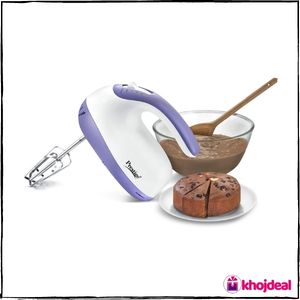
Why we like this electric beater?
Bring home the new Prestige electric beater and save precious time and effort without compromising the perfect mix. It comes with 300 watts motor, thus making it time saving and efficient. With twin beaters and adjustable speed levels, the electric beater is highly recommended by professional bakers, chefs, and cooking enthusiast. It is featured with 3-speed controls for perfection in every preparation.
The electric beater is uniquely designed for easy operation, and it is very easy to clean and maintain the appliance. It comes with two high-quality stainless-steel attachments for added utility. The whisker attachment performs whisking jobs and dough hook attachment can ideally be used for whipping, blending, and mixing. It can be a perfect gift for your loved ones.
Key features & specifications
- 300 watts power
- 2 stainless steel attachments
- Variable speed control
- Easy to clean
- Warranty: 1 year
- Attractive & colorful design
- Power supply: 230 V
- Multi-purpose
- Energy efficient
- One-button attachment pop-up
- Ergonomic design
- Snap-on storage case
- Powerful DC motor mixes with ease
- Maximum continuous usage is 15 minutes
Pros & Cons
Pros (What we liked)
- Handle is built with a comfortable grip in mind
- Convenient snap-on storage case keeps attachments and cords together so you don’t have to search for them each time
- A special turbo button provides a quick boost of power
- Saves precious time and effort without compromising the perfect mix
- High power motor effectively improves the stirring speed
Cons (What we didn’t like)
- A bit heavy; weight is about 1 kg
4. Bajaj 250-Watt Electric Beater (HM-01)
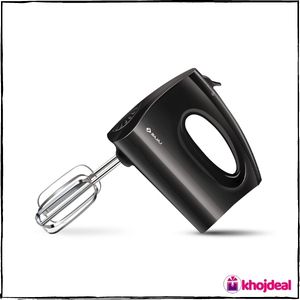
Why we like this electric beater?
The Bajaj HM 01 250-Watt electric beater comes with 3 speed controls for preparation of various dishes. The dough hooks and beater attachment rotate in low, medium, and high speeds. Its 3-speed control function lets you adjust the speed of the motor according to the ingredients you are processing for perfect blending results.
This Bajaj HM 01 250-Watt electric beater comes with a dough hook attachment. The dough hooks are best for kneading bread dough, pizza dough and mixing tough cookie batter. This electric beater houses a beater attachment too. The beater attachment is best for making whipped cream from cream, beating eggs to make a meringue, or mixing thin cake batter.
Key features & specifications
- 3 speed controls
- Crome-plated dough hooks and beater attachment
- Stylish design
- Warranty: 2 years on product
- Power: 250 watts
- Voltage: 230V, 50Hz
- Eject button
- Slicing/push switch
- Body material: ABS
- Cord length: 10m
- Matt finish
- Premium look
- Easy to clean
- Lightweight and easy to operate
- 2 minutes on and 3 minutes off duty cycle
Pros & Cons
Pros (What we liked)
- Flaunts a stylish design with black matt finished exterior
- Powerful motor ensures effortless and fast blending
- 3 speed control function lets you adjust the speed of the motor according to the ingredients you are processing for perfect blending results
- Eject button helps you easily attach/detach dough hooks and cake beater attachment
- Slicing/push switch enables convenient and safe operation
Cons (What we didn’t like)
- Even lowest speed is too much; Ingredients spill a lot since speed cannot be controlled beyond the minimum
5. iBELL 120-Watts Electric Beater (IBLWHITES03NEW)
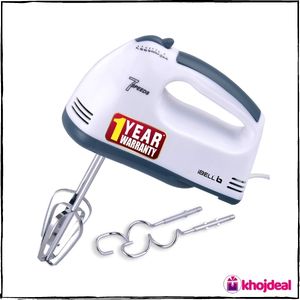
Why we like this electric beater?
Mix, whisk, and whip batters, spreads, and dips quickly and easily with the iBELL 120-watts electric beater. This must-have kitchen appliance is designed with a comfortable handle and powerful motor to deliver 7 speeds of mixing power to help you whip up your favorite dishes. It is durably constructed with a 120W motor that is powerful enough to get the job done for experienced and beginner chefs alike.
The beater comes with two chrome-plated beater attachments with a tapered design and flat ends that allow them to reach fully into ingredients while avoiding the insides of the mixing bowl. It makes a useful addition to the rest of your kitchen appliances. The sleek look and simple color will mix well with most kitchen decor. Get your recipes mixed up and ready to cook using this iBELL electric beater.
Key features & specifications
- Compact and lightweight
- Powerful
- Multi-tasking beater
- 2 pairs of stainless-steel beaters and dough hooks
- 7 speed control
- Power: 120 watts
- Operating voltage: 220-240 volts
- Attachments are dishwasher safe
- Durably constructed for a long life of use
- Ejector button
- Comfortable 1-hand operation
- Easy to clean
- Ergonomic handle
Pros & Cons
Pros (What we liked)
- Designed with a comfortable handle to help reduce fatigue during use
- Easy-to-use speed control and ejector button
- Instantly blends ingredients together seamlessly with its high-quality chrome beaters
- Does not heat up even after 15 minutes of continuous use
- Extended warranty gives added advantage
Cons (What we didn’t like)
- Rotary switch for speed is very delicate and feels like will come off any time soon
6. Usha 300-Watt Electric Beater (3732)
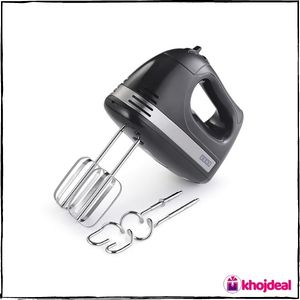
Why we like this electric beater?
The versatile Usha HM 3732 300W electric beater is a compact high-speed beater designed for comfortable operation and avoiding fatigue during heavy or longer duration mixing tasks. This versatile electric beater has 5 different speed options for a wide range of mixing tasks, plus a turbo feature that allows for an added boost to the selected speed setting at the press of a button.
Air vents placed strategically help to prevent clogging from batter and other mixtures. A detachable storage compartment houses all the attachments and swivel cord, reducing the chance of the electric beater accessories getting lost or misplaced. The 1-meter cord length allows you to maneuver the beater according to your needs while the ergonomic design makes mixing convenient at any angle.
Key features & specifications
- Premium stainless-steel finish
- 5 speeds and turbo setting
- 1 press ejection for easy cleaning
- Copper motor for longer life
- Overload protector for motor safety
- 2 stainless steel hooks for mixing and kneading
- Ergonomic handle for better grip
- Air vents to avoid clogging
- 1 meter long 2 pin power cord
- Smart box for easy storage of accessories and cord
- Accessories: 2 beater hooks and 2 kneader hooks
- Warranty: 2 years warranty provided by the manufacturer from date of purchase
- Power: 300 watts
Pros & Cons
Pros (What we liked)
- Integrated beater eject button allows you to release the beater hooks smoothly
- Handle is designed for comfortable operation and avoiding fatigue during heavy or longer duration mixing tasks
- Powerful motor enhances beater performance and allows it to blend extremely tough ingredients for better results
- Overload protector ensures that your copper motor is safe to always provide efficient functionality
- Premium stainless-steel finish gives the beater an amazing look along with durability
Cons (What we didn’t like)
- Appliance can be a bit noisy when working
7. Orpat 150-Watt Electric Beater (OHM-207)
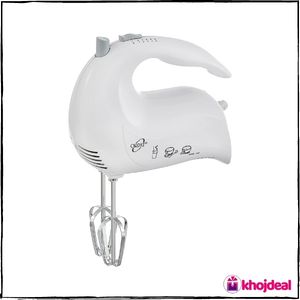
Why we like this electric beater?
Mix anything from whipped cream to cookie dough, or even make a milkshake with the Orpat OHM-207 5 Speed electric beater. With beater blades crafted in high quality stainless steel and five convenient speed settings, this handheld beater cuts through everything. The beater is crafted with sturdy handle that ensures comfortable grip that makes certain it doesn’t slip from your hand while mixing or blending.
With 150 watts of peak power, this electric beater gives you ultimate control over your mixtures, from slow-speed pulse to high-speed burst. Operation is so simple that anyone can make delicious recipes like a real pastry chef. Just place the whisks, choose the speed and the beater will start working. Once done, just press the eject button to separate the rods and clean them easily.
Key features & specifications
- 5 speed settings
- Modern ergonomic design
- Eject button
- Comfortable grip handle
- Finger strip speed control switch
- Warranty: 1 year on product
- Power: 150 watts
- Frequency: 50 Hz
- Blade Material: Stainless steel
- Operating voltage: 230 volts
- Stainless steel dough hooks & beater blade
- Adjustable swivel cord
- Wall mounting stand
Pros & Cons
Pros (What we liked)
- Hygienic stainless steel dough hooks & beater blade for durability and strength
- An adjustable swivel cord allows mixing without interruption
- Wall mounting stand for easy to store appliance and beater & dough blade
- Powerful motor thanks to which you can prepare all types of recipes
- Body is made of durable plastic which is safe for contact with food
Cons (What we didn’t like)
- The whisk can be used at maximum speed for short periods only to avoid overheating
8. Morphy Richards 300-Watt Electric Beater (HM02)
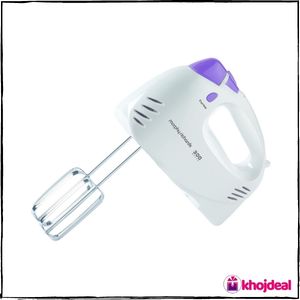
Why we like this electric beater?
The 300-watt powerful motor of HM02 electric beater is good enough to blend the toughened food ingredients at one go. The 5-speed control provides you with different options so that you can work with different types of foods that are soft and hard. An extra turbo button that you can manually switch on to blend tough ingredients adds to the power of the beater.
The soft-grip handle makes mixing an effortless process. The ergonomic design of this beater fits comfortably in the grip allowing a wide range of movements effortlessly. Now you don’t have to tire yourself by kneading the dough or mixing the batter with your hands, as this electric beater from Morphy Richards will get the job done in a jiffy.
Key features & specifications
- Beater attachments
- Kneader hook attachment
- Whisker attachment
- Turbo function
- 5 speed control
- Warranty: 2 years on product
- Power: 300 watts
- Operating voltage: 230 volts
- Soft-grip handle
- Eject button
- Easy to clean
Pros & Cons
Pros (What we liked)
- 5 speed switch control to cycle through the speeds for all your mixing and baking needs
- Simple eject button to quickly release beaters
- Ergonomic handle provides comfort while in use
- Benefits from an easily transportable, compact & portable design
- All accessories included are dishwasher safe and easy to clean
Cons (What we didn’t like)
- Speed button is a bit tight; hard to switch off or change speed
9. Wonderchef Electric Beater (Oynx)
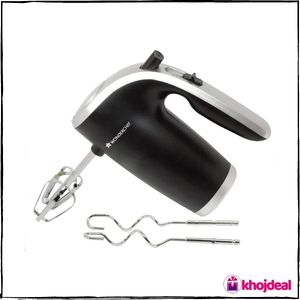
Why we like this electric beater?
Prepare healthy and delicious homemade food with the superior performance of the Wonderchef Onyx electric beater. You can make cakes, pancakes, mashed potatoes, fluffy dough, blend soups your imagination is the limit. With the help of stainless-steel beater hooks one can mix heavy ingredient. Make the dough for pizzas, rotis and bread with perfect texture and consistency comfortably.
This electric beater from Wonderchef is designed to fit in to your hand firmly. Its ergonomic design helps you to keep the beater steady and well balanced while using. The appliance is equipped with a copper motor which makes it low maintenance and super powerful. Its small size takes up little kitchen space, and its sleek design and classic color options will match any kitchen decoration.
Key features & specifications
- Stainless steel beater and kneading hooks
- Ergonomically designed handle
- Easily removable attachments
- Copper motor for longer life
- Reliable Wonderchef warranty
- 5 speed settings
- Thumb operated speed control
- One Button Eject
- ABS plastic body
- Easy to clean
Pros & Cons
Pros (What we liked)
- Speed settings are all thumb operated which makes the electric beater easy and convenient to use
- Food-grade stainless steel accessories are healthier and safer than other materials
- Compact design and comfortable grip reduce the burden on the arm
- Mixing attachments are easy to install and remove
- Compact storage base keeps everything in one place
Cons (What we didn’t like)
- No turbo speed button
10. Black and Decker 250-Watt Electric Beater (MX3200B)
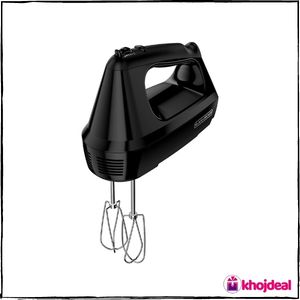
Why we like this electric beater?
The Black+Decker 6-Speed electric beater is for every mixing task. With five dishwasher-safe attachments, you can easily stir, beat, whisk, whip, and even work with dough. The powerful 250-watt motor can do it all in no time. Plus, the starting speed is 20% slower than previous Black+Decker electric beaters, eliminating messy mixing for good!
The hard-shell storage case keeps the beater and all its attachments in one spot. For getting through tough mixing tasks, the TURBO button increases the beater to its maximum speed. The heel of the beater is designed to rest upright on the counter or sit on the edge of the bowl. Cleanup is easy thanks to the dishwasher-safe mixing accessories.
Key features & specifications
- 250 watts peak power
- 6 speed settings
- Lightweight and ergo dynamic design
- Bowl and heel rest
- Traditional storage case
- 5 professional-style attachments: 2 beaters, 2 dough hooks, 1 whisk
- Turbo boost
- Easy eject button
- Volts: 120 V
- Dishwasher-safe removable parts
- Slower starting speed
- Storage case
Pros & Cons
Pros (What we liked)
- 6 speeds plus turbo boost help find the right speed for optimal consistency
- Cleanup is easy thanks to the dishwasher-safe mixing accessories
- Comes with a storage case to holds all included accessories and the beater
- Turbo boost button automatically increases the beater to top speed for tough mixing tasks
- Slower starting speed helps prevent splatter and loss of ingredients
Cons (What we didn’t like)
- Weight of appliance is on higher side; you get tired after holding it for 30-40 seconds
Electric Beater Buying Guide
Comfortable and very practical in use, a beater is a device that can be found in most kitchens. But the various features of this product which are becoming more and more sophisticated often confuse many people who are planning to buy one. Hence, it is necessary to take into account some selection criteria concerning which we are going to give you some advice: the material, the power and the speed.
1. Performance
A fundamental characteristic for obtaining satisfactory results is that this instrument is able to provide adequate performance for its use, and it is for this reason that among the first aspects to be taken into consideration for choosing the model that best suits your needs is the engine power.
The power of the motor, expressed in watts, tells us not only which ingredients the electric beater is able to work, but also their quantity and the maximum duration of use. On the market you can find models from 150 W up to about 450 W: the most powerful ones are suitable not only for mixing liquids and creams but are also able to work doughs of greater consistency and quantity.
In this regard, we remind you that the instruction booklets (often available online on the manufacturers’ websites) often recommend the maximum amount of dough to be worked at once to avoid over-tiring the engine. Electric beaters are in fact tools designed for domestic use and for preparations that do not require more than about 5 minutes to process.
Sometimes it is even possible to find the maximum duration of use specified in the instruction booklet of the appliance, which will be directly proportional to the power of the motor. It is also good to remember never to carry out several consecutive cycles, but to always let the engine cool down before starting it again.
For those who need to work large doses of dough at a time, we have already said that it is better to opt for the purchase of a good planetary beater, which not only performs the same functions, but is also able to work larger quantities of kneading for longer periods of time.
2. Functions
Secondly, the functions available are what make an electric beater more or less versatile. As a general rule it can be said that the more features included, the easier it is to get perfect results. In fact, it is essential for each recipe to select the right speed and the right processing time. So, let’s see what are the most common functions that can be found on an electric beater.
a. Speed
Imagine having to whip egg whites until stiff: if the speed of the whips is excessive, the only result we will get will be that of splashing egg white all over the kitchen. It is therefore essential that the beater has different speeds thanks to which to modulate the rotation of the whips according to the density of the ingredients and intensify it as the dough or mixture becomes denser, or vice versa. On average, the expected speeds are 5, but models with more than 5 speeds can also be found.
b. Turbo
In some cases, it may be necessary to significantly intensify the rotation of the whips for a few seconds and then return to more moderate speeds, for example to melt lumps or pieces of butter. In these cases the turbo function can prove to be very practical, for which however an operating time of a few seconds must be provided.
c. Pulse operation and continuous operation
In some cases, it is possible to choose between an impulse and a continuous operation. What does it mean? In the first case, the user must hold down the start button until the mixture has reached the desired consistency and release it only at the end of preparation.
This solution can be practical when the ingredients require only a few minutes to mix, but in general it is not recommended, especially for those who want to use the electric beater also to prepare dough for bread or pizza that generally require several minutes of processing.
In this case it is better to make sure that there is also a continuous operation button, even more so if the beater is, as we will see, equipped with a bowl.
3. Structure
As we have just mentioned, there are two large categories of electric beaters: the traditional ones, equipped with a single machine body containing the motor to which the whips are attached, and those also equipped with a support structure and bowl , with a shape very similar to that of the planetary. Let’s see what the main advantages and disadvantages of each of the two types are.
First of all, before delving into this distinction, it is important to check the weight of the beater body, especially if it is a traditional model and you plan to use it frequently. L ‘ ideal would be that in fact no more than 1.2 kg weights, so as not to tire the arm even after a few minutes of use. However, it is useful to remember that the low weight pays off when you have to mix for a long time, but a heavy device usually indicates a bigger and more powerful motor, therefore able to work heavier doughs.
a. Traditional electric beaters
They are the classic ones that can be found in almost all kitchens because they have small dimensions and can also be stored in drawers. They can also be quite cheap and don’t require a lot of maintenance. The main disadvantage is that they do not necessarily adapt to the bowls already present in the house, so it may be necessary to separately procure one or more bowls with an adequate depth to work the ingredients and a material that does not deteriorate under the blows of the whips.
b. Electric beater
These electric beaters have a larger footprint, so not all kitchens may have the necessary space to place them. On the other hand, the advantages are manifold. First of all, they are supplied with a support and bowl on which to be positioned, so they can work in complete autonomy. For this reason, they require less effort and are ideal for older people, for example. Furthermore, unlike kneading machines, the machine body is removable, and the beater can also be used with other containers or pots.
If you intend to buy an electric beater equipped with a bowl, you will need to take into account some secondary but still important aspects. First of all, it is good to make sure that the whips are able to reach and work all the mixture or the whipped. It is therefore better to prefer models in which the bowl is not positioned perfectly flat but is slightly inclined, so that the ingredients accumulate on one side and are more easily accessible.
A valid alternative is for the bowl to rotate on itself, so that the centrifugal force of the whips does not push the ingredients to the edges, but vice versa collects them in the center. Finally, it is useful that there is a lid to block splashes, so as to limit the work surface from getting dirty.
4. Whips
An advantage of electric beaters compared to manual ones is that they are often equipped with whips of different shapes and sizes to be chosen according to the type of processing.
This also means that the whisks can be removed from their support and washed comfortably in the dishwasher or by hand. Even if you decide to opt for a model with only two whips, we therefore recommend checking that these are removable to be able to wash them more easily without fear that splashes of water can reach and damage the engine.
The presence of an eject button will help avoid getting your hands dirty to remove the whips and making incorrect movements risking bending them while trying to remove them from the body of the electric beater.
Most electric beaters come with two standard whisks (used for cakes and eggs) and two spiral hooks (suitable for thicker doughs). In rare cases it is also possible to find one or two wire whips, thinner than the standard ones and designed to incorporate the air in order to create soft and foamy whips. In the absence of these, it will still be possible to use normal whips.
It is particularly important to always check in which material they are made and opt for models in stainless steel, in order to avoid using whips in poor materials, which could be unusable after a short time. Stainless steel is in fact both resistant and, as the name suggests, stainless. If you intend to buy a model that also comes with a bowl, it is advisable to prefer those in steel or other metal alloys, as they are more resistant. On the other hand, for plastic bowls it is important to check that they are BPA Free, i.e., free of bisphenol A, a substance that is harmful to the body.
5. Practicality of use
Before proceeding with the purchase, it is also good to consider those small tricks that simplify or make it more convenient to use the electric beater: although they may be of little importance, it is in fact precisely those details that make the difference between one model and another.
- Handle: Better to prefer an ergonomic handle with rubber inserts to be able to firmly grip the electric beater even if the hands are not perfectly dry.
- Support: Furthermore, some models have the advantage of having a structure with a flat base or equipped with a support foot, which allows it to be placed vertically on the worktop next to the bowl so as to drain the whips without getting too dirty. Below you can see a blender with a base.
- Cable: The length of the cable is also not to be underestimated, because it must be such as to allow an adequate margin of movement. A good beater should have the cable about 1m long, but it is fair to point out that the length of the cable is almost never indicated by the manufacturer. The presence of a cable reel also makes it easier to store and store the electric beater.
- Whip holder: Very convenient is also the presence of hooks on the back or special cases where to place the whips when not in use, so as not to lose them around in the drawers or forget them in the kitchen in some unusual location.
- Compatibility: Finally, for those who do not already have many other appliances in the kitchen, it might be useful to opt for a model compatible with other accessories of the same brand such as food processor and hand blender, in order to have only one motor body for different appliances.
Frequently asked questions about the electric beater
1. What are the best brands of electric beaters?
Almost all kitchen appliance brands have at least one electric beater model in their catalog and often the differences between the models of different manufacturers are really imperceptible. We can therefore rely on the brand with which we have found ourselves well in the past for the purchase of other kitchen appliances, preferring those with reliable customer service and with assistance centers spread throughout the territory. These include Bosch, Philips, Inalsa, Usha and Prestige.
2. How to clean the electric beater?
Given the large number of efficient electric beaters on the market, it may be the small details that influence your purchase decision. In our opinion, the possibility of washing the whisks in the dishwasher is part of the criteria to be considered when choosing an electric beater, especially since the dough can become very hard when it dries and therefore difficult to remove.
For this reason, we recommend soaking the whips in hot water with dish soap immediately after use, whether it is dishwasher-safe or hand-washed accessories.
The camera body, on the other hand, must absolutely not be immersed in water, but should be cleaned with a damp cloth when necessary, possibly when the stains are still fresh.
3. How to use the electric beater?
As we have seen, the electric beater is ideal for making different preparations. The use of this tool is easy and intuitive, but before using it, make sure to insert the correct whips: the classic ones for cakes, eggs, or cream; spiral ones for bread, pizza, or focaccia. Remember to perform this step, as well as removing the whips when the appliance is off.
Now we come to the processing of the ingredients: if you have to mix only dry ingredients together, it is preferable to use a manual whisk instead of an electric beater. To avoid accidental splashes, it is also recommended to activate the beater only when the whips are already inside the container of ingredients.
For heavy machining, such as the dough for biscuits or bread, the lower speeds are preferred to obtain a homogeneous amalgam, while for the more liquid preparations the higher speeds are indicated to obtain a creamy and denser consistency.
Be careful to gradually switch from the lowest to the highest speeds: if you are at speed 1 and you go directly to 4 it is very likely that your mixture will splash out of the bowl. Finally, unplug the appliance from the electrical socket before removing the whisks and washing them.
4. What is the difference between an electric beater and a standard beater?
In the past, the only option we had for mixing food ingredients was to beat them manually or by using mechanical tools that used physical force to work. While they were effective, they required a lot of user effort and sometimes the ingredients weren’t blended well. Plus, it took a long time to mix all the elements of a recipe together.
Today we have the option of using an electric version of these devices. Using an internal motor, powered by electricity, it is possible to quickly mix the different ingredients and obtain a homogeneous and easy to use mixture.
Another advantage that we can get from this type of beater is that with it it is possible to create dough for bread or biscuits. Using the indicated heads, it is possible to knead without getting your hands dirty with flour.
They are popular in the kitchens of people working in the kitchen area, as well as being frequently found in homes around the world.
5. How to choose the model that best suits your needs?
When choosing a particular model, it is essential to ask yourself what the electric beater is for and what features are most convenient for us. Only in this way will we be able to acquire equipment that perfectly suits our expectations.
It is important to choose a beater that has the accessories we will need. If we are going to use it to prepare different breads and doughs, it is recommended to buy a model that has additional hooks for kneading.
If you plan to use the beater for professional use, the ideal is to choose an appliance that has a powerful motor, but which is also made with high quality materials that guarantee resistance, power, and durability over time.
6. What are useful accessories for an electric beater?
An electric beater rarely comes without accessories. But what makes sense, what can you do without? Normal stirring hooks are standard accessories for an electric beater. If you like to make yeast dough, you should make sure that dough hooks are also included in the scope of delivery of the electric beater.
Electric beaters that do not have smooth cables, but so-called spiral cables are also very practical. It can be rolled out a long way, but if it is not in use, it can be folded up to save space. Some electric beaters also have a kind of stand below the housing so that you can conveniently put the electric beater down.
7. Which is better: electric beater or hand blender?
This question is difficult to answer across the board. Since electric beaters and hand blenders have two different areas of application, it is advisable to have both devices in the kitchen. Hand blenders can not only mix the ingredients, but also puree them at the same time. Electric beaters, on the other hand, mix ingredients into smooth, homogeneous masses. Especially if you often prepare sticky types of dough, such as yeast dough, you definitely need a electric beater with a dough hook.
8. Which electric beater is suitable for processing bread dough?
A electric beater should meet several requirements for reliable processing of bread dough. It needs dough hooks and a medium to strong motor with between 30 and 450 watts is working. It is important that the beater can also work at a low speed – i.e., has different speed levels.
9. Which electric beater is suitable for yeast dough?
Because of their chewy consistency, yeast doughs can be a major challenge for electric beaters. Experts recommend devices with the highest possible output of more than 450 watts.
10. How long can I use a electric beater without interruptions?
Electric beaters are not designed for continuous use. For most models, the maximum usage time can be found in the operating instructions – rarely more than 3 minutes. If you use your electric beater for longer without interruptions, you run the risk of overheating, which can damage the motor.
Conclusion
Less expensive than a food processor or planetary beater, an electric beater is ideal for quick tasks like whipping cream or egg whites, but also for kneading small portions of leavened products. And they are much cheaper. But which electric beater to buy?
Whether you want a “manual” one or with a bowl, it doesn’t matter. After testing the most modern and popular models, our top pick is Philips HR3705/10 300-Watt electric beater. It comes with a lightweight, ergonomic design that makes mixing comfortable and easy.
